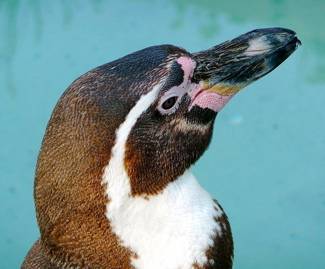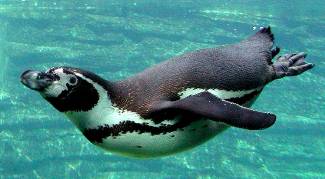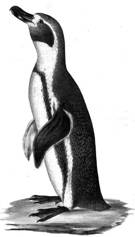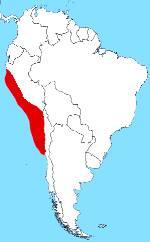Humboldt Penguin
Spheniscus humboldti
Online Biology Dictionary

EUGENE M. MCCARTHY, PHD
<|
|

|
|
Humboldt Penguin (S. humboldti) Order: Sphenisciformes Image: Zauer |

|
| Spheniscus humboldti: Diving. Image: Wilfried Wittkowsky |
Humboldt Penguin
Spheniscus humboldti
This bird, also known as the Peruvian Penguin or Patranca, is one of the banded penguins (genus Spheniscus, see below). A medium-sized penguin, up to 65-70 cm (~26-28 in) in length and weighing 3.6-5.9 kg (~8-13 lbs), and, like other penguins, flightless, it is an excellent swimmer and diver. Sexual dimorphism is lacking. The feet are black and unusually thick. The iris is golden brown. The undersides of the wings are yellowish. On their tongues, these birds have six rows of small protuberances that are thought to assist them in holding their prey. The external anatomy is otherwise clear from the pictures shown.

|
| S. humboldti (from Meyen's original report) |
Discovery: Between 1830 and 1832, the German naturalist Franz Julius Ferdinand Meyen (1804-1840) took part in an expedition to South America, visiting Peru and Bolivia. Subsequently, he wrote the first description of Spheniscus humboldti (Meyen, 1834, Nova acta physico-medica Academiae Caesareae Leopoldino-Carolinae ...: Volume 16, Part 2 - Page 110, Halle). He named it for his countryman, the famous Alexander von Humboldt, who had reported seeing this penguin while in Peru, but did not formally describe it.
Diet: Fish and crustaceans.
Conservation status: Vulnerable, due to over-fishing and habitat destruction. The total current population is estimated at about 10,000.

|
|
Range of S. humboldti
Map: NRG |
Geographic range. Peru southward to the central Chilean coast where it hybridizes with the Magellanic Penguin (Spheniscus magellanicus). Humboldt penguins breed on rocky coasts where they nest either in burrows or in natural caves and hollows. Outside the breeding season, this bird is pelagic, occurring far out to sea (see map, right).
Genus Spheniscus. The Humboldt penguin belongs to genus Spheniscus, the banded penguins. Also known as jack-ass penguins because their loud calls sound like a donkey brays, penguins of this genus share a band of black that runs around their bellies, black beaks with a vertical white band, scattered black spots on their bellies, and a glabrous or sparsely feathered patch of skin around their eyes, which is either white or pink. Spheniscids lay their eggs and raise their young in burrows.
By the same author: Handbook of Avian Hybrids of the World, Oxford University Press (2006).
Most shared on Macroevolution.net:
Human Origins: Are we hybrids?
On the Origins of New Forms of Life
Mammalian Hybrids
Cat-rabbit Hybrids: Fact or fiction?
Famous Biologists
Dog-cow Hybrids
Georges Cuvier: A Biography
Prothero: A Rebuttal
Branches of Biology
Dog-fox Hybrids